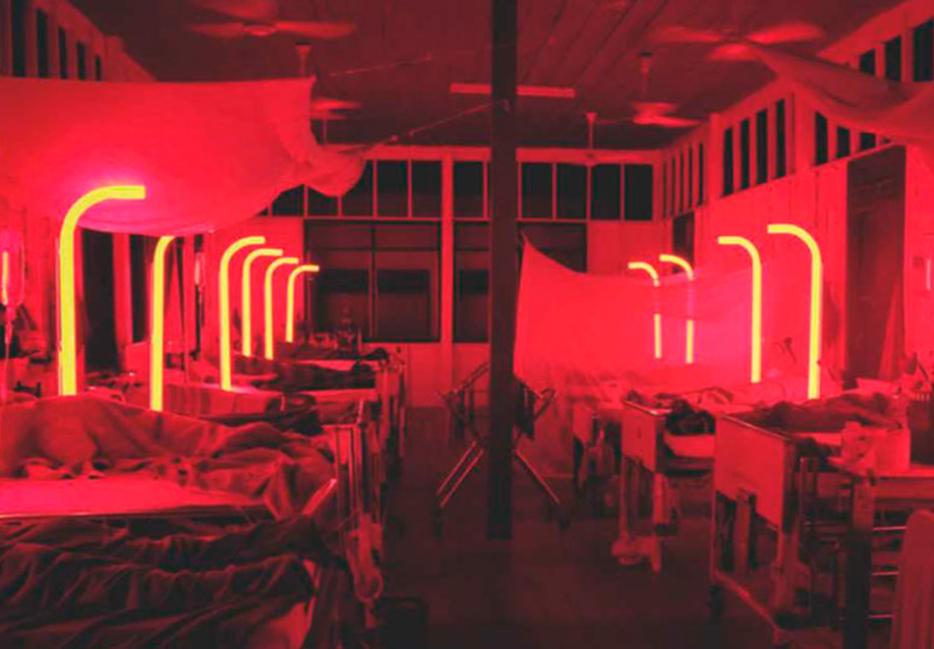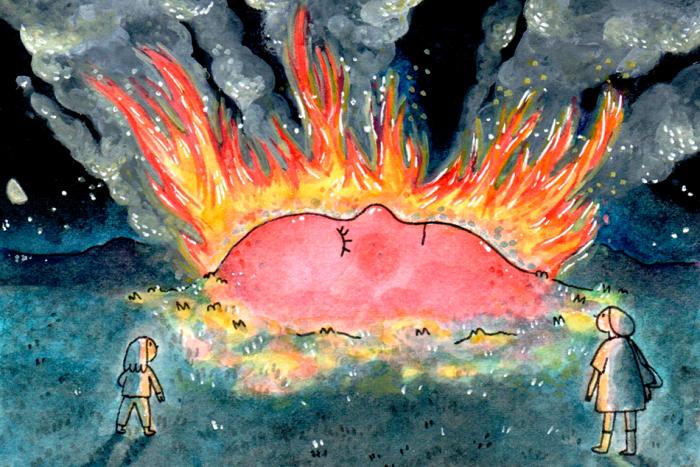Apichatpong Weerasethakul has a way of getting inside your head—or maybe we’re getting inside his. It’s become something of a cliché to call Weerasethakul’s movies dream-like, but that really is how they feel: uncanny but distinctly personal, like private visions. So it seems only appropriate that the Thai director’s latest feature, Cemetery of Splendour, should take the world of dreams as both its subject and locale. Who better to explore the realm of sleep than cinema’s foremost expert in the terrain?
Weerasethakul is Thailand’s most widely celebrated filmmaker and a longtime fixture of international arthouse cinema. He won the Palme D’Or in 2010 for his last feature, Uncle Boonmee Who Can Recall His Past Lives, and he’s enjoyed a great deal of critical success with Cemetery of Splendour since its premiere out of competition at Cannes last May. This new film finds Weerasethakul at his most characteristic: shot in his hometown of Khon Kaen, where it is deeply engaged with the politics of the region, and starring Jenjira Pongpas, with whom he’s frequently collaborated, Splendour is unmistakably the work of its director. And yet it’s perhaps more restrained: though we’re plunged into the dreamscape, there isn’t a red-eyed monster or talking catfish—two of Uncle Boonmee’s most memorable stars—in sight.
Cemetery of Splendour arrives at last this week in Canada after nearly a year on the festival circuit, where it screened to much acclaim in Cannes, New York, Vancouver, and Toronto. We sat down with Weerasethakul amid the frenzy of the latter to talk about politics, dinosaurs, and, of course, dreams.
*
Calum Marsh: In some ways I think this is the quintessential Apichatpong film.
Apichatpong Weerasethakul: Hmm. For me this is a quite different thing. It’s the first time that I let Jenjira almost take over the film, its direction and movement. It’s almost like we were collaborators—particularly our mutual feelings about the country. So I view it quite differently from my other films.
Stylistically, too?
Stylistically… ooh, maybe yes, it’s similar. In a way. In the beginning we planned quite a lot of fantastic scenes—with monsters and fantastic things like that. But then we shot them and cut them out, because I realized in the editing room that Jenjira is very strong. We cut the scenes with her husband out, we cut the monsters out.
Monsters!
Yes, monsters. They were supposed to appear in the lake from time. But emotions are more important than monsters. The direction of the film is toward the mundane and the ordinary, so I preferred to focus on that.
Were the monsters digital?
No no, we didn’t use CGI.
Real monsters.
[Laughs] Yes.
But you did use extensive post-production effects elsewhere.
Yes. I think that’s as far as I wanted it to go. The core of cinema, I feel, is this power of suggestion, and I just want to keep that. I wanted to underline that this is a movie—one that would put the audience in a state where the imagination is very active, but at the same time you feel confused about what you see and what you hear. Like Jenjira herself. Those feelings are synchronized. The movie itself may be hypnotizing the audience in the colour sequence. Of course, by not overtly presenting something unreal—like in Tropical Malady, say—it doesn’t really make the producers happy, because they’d really like to have monsters. [Laughs] But for me I think when I look at my dreams, it’s so not like movies—so not like dreams in movies. Movie dreams look like Salvador Dali paintings or something. But in fact our dreams are very simple. I don’t know about you…
My dreams are quite mundane, yeah.
Yeah. It’s just that the logic is so different and so strange. Suddenly there’s a new character here and we subtly change to another scene. So I tried to maybe emulate that a little. But I think movies themselves are like dreams already. When I did research on sleeping I found that we have these stages of sleeping, and each night we go through these cycles—REM and so forth. These cycles last ninety minutes. So I thought maybe that’s where the length of movies came from, from dreams.
I agree with you that my dreams aren’t like movie dreams. But I do wonder if our dreams would be much different if we were living in the 19th century, before cinema.
Yes, yes, the timing would make a big difference.
The language of movies informs the way we think about things and the way we dream.
Or the way we memorize things. Our image of the past is shaped by a cinematic language.
Falsely, of course, because that’s not how reality actually works.
And then you question what is reality.
“Dream-like” is a term we use a lot to describe movies that’s just vague enough. But this really does feel dream-like. The only other films I can think of like that are Mulholland Drive or Inland Empire…
Mmhmm. I like David Lynch’s films, but it wasn’t on my mind. For me it’s all very local, the logic. I like to write down my dreams and this is developed in an internal, organic way.
Much of this was inspired by your real dreams?
Yes, yes. Uncle Boonmee as well.
Did you want it to be clear when we were or were not in a dream, so to speak?
No no no. I don’t want to underline that this is a dream or not. We always treat everything as reality. Jenjira as well. Maybe, after a while, we established with my editor that okay, after the night in the school it could be a dream, because suddenly she’s out on this picnic with the guy she likes. So maybe about this point, tentatively.
But you wanted it to remain ambiguous for the audience.
Yes, and for me too. I don’t want to know either.
Not like Inception, exactly.
[Laughs]No. But I do love Inception. Yeah yeah.
So no monsters in this film—but you do have dinosaurs. The dinosaur statues that are scattered around the city are quite striking.
[Laughs] Yes. But that’s our reality. Ten years ago in Khon Kaen we had big news that they discovered dinosaur bones there. So it became this big archaeological site. Suddenly the city adopts this as a symbol: now we have a lot of dinosaur sculptures everywhere.
For me they seemed at first a part of the dream.
There it’s a normal thing. I know it can be looked at in different ways, whether it’s a commentary on this country or whether it’s just there as an archaeological record. In fact, we had more dinosaurs, but we cut out a lot of them. A local audience would know. The film is not released there, but I don’t think they would even notice.
How much in this film is going to elude an international audience?
A lot. [Laughs] Many things I cannot say because we are in a very crazy time in Thailand right now. There are things to do with the colours, the political colours. In Thailand we apply meanings to colours, political meanings. There are also references to the past dictator and the current one. But I don’t know. I mean, my intention, as with all my films, is to make it for myself. How do I channel these feelings I have in a way that doesn’t seem like I just read a book? A film can continue to inspire you to other points.
Do you mind if people don’t fully apprehend the political import?
No no no. You can look at different films—you can look at The Martian, even—in different ways, as a political film or not. When I look for films, also, I prefer ambiguity. In fact that’s why I was a bit upset with Jia Zhangke’s new film—because I feel I need more room to see and to think. I didn’t like it. It was too direct and… too short.
Is that room, that freedom, rigorously structured, or is it more intuitive?
We don’t have much room for improvisation because of the budget. But we do kind of improvise before, in the rehearsals, to develop things. This film was the most straightforward for me in terms of the blueprint to the finished product. We shot quite a lot but compared to my other films it was pretty clear from the beginning.
You favor long takes.
Yes.
How do you decide how long is long enough?
It’s impossible to say. It’s about… everything. And in the editing room, as well, but I don’t know. I think like any filmmaker you just shoot and react to that specific moment of the shooting. In the editing it changes because it has a relation to other shots before and after. That’s why, I think, filmmaking is still attractive—because it’s malleable.
Does it change much for you, from shooting to editing?
The things that are there, not much. But there’s a lot of material we cut out. We had a lot of her husband at home that we removed in this film. A lot of things I shot because I needed to see it but even questioned during shooting whether it would end up in the film. I shot rain in the garden and the city at night—things I was suspicious that were just to satisfy me or inspire another scene.
What attracts you to a location?
Maybe I feel like I really love this small town life. The big city doesn’t inspire me. I lived in Bangkok for more than ten years and every time I went out in the country to shoot it was like an excuse to get out there. Now I live in a very small town. Most Thai movies are very focused on the city. But I feel I need to go out further. The country is very centralized around Bangkok, so I feel I want to liberate the power to make the small town seem big.
A lot of American films are shot in Bangkok too these days. They always look the same: all that neon.
Our lights were LEDs. I worked with my production designer and was inspired by the lights in my own house. My house is just right by the military camp and just two years ago they erected this fence—almost like a concentration camp fence, with the curved rail—and the light rods in the film were inspired by that. But now people keep telling me they look like candy canes.
It had occurred to me.
Well, that’s right. We designed it to have a really small changing light inside. I was really intrigued by this study at MIT about the colour spectrum and the wave of colour that can fabricate memories in mice. For me that’s a big deal, a big discovery, since I’m interested in all this brain science. So the film is a reflection of that. It tries to mess with your memory.
It’s a great image, too: the room of lights looks incredible.
We didn’t expect this. But when the set was done and the cameras were ready to roll we realized: wow, this is like a huge art installation! Now they’re in storage. Maybe I can sell them. But actually it was linked to a computer, so maybe it’s too complicated.






